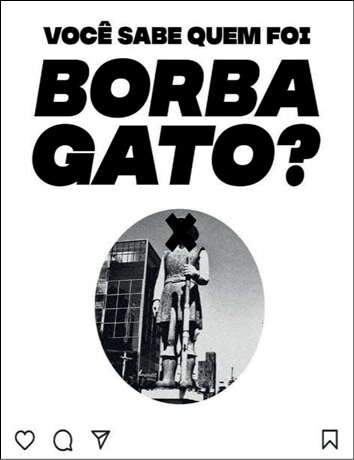
Politologija ISSN 1392-1681 eISSN 2424-6034
2024/2, vol. 114, pp. 55–80 DOI: https://doi.org/10.15388/Polit.2024.114.2
Lilian Alves Gomes
Associate Professor at the University Research Institute
of Rio de Janeiro (IUPERJ) of the Candido Mendes University (UCAM)
E-mail: lilian.gomes@candidomendes.edu.br
Abstract. This article reflects upon objects and actions of counter-memory activism in Brazil in the wake of anticolonial demonumentalizations. Initially, it focuses on statues symbolizing colonial and traumatic pasts, notably the Borba Gato statue in São Paulo, dedicated to a colonial explorer. The monument was set ablaze in July 2021, sparking widespread debate. The discussion deepens with the commemoration of Marielle Franco, a councilwoman and human rights advocate who was murdered in 2018. The interplay between memory initiatives and political activism is examined, with tributes analyzed as collective authorship by black and feminist movements. Ethnographic data from Rio de Janeiro and digital environments inform this analysis. Events related to monuments and other objects are viewed as political rituals in the struggle against forgetting. Statues, street signs, graffiti, posters, and other forms of counter-memory supports are identified as focal points for understanding the relationship between objects, artistic-political practices, and public life.
Keywords: monuments, public statues, critical toponymy, counter-memory, memory activism, cultural heritage, Marielle Franco.
Santrauka. Šis straipsnis apmąsto kontratminties aktyvizmo Brazilijoje objektus ir veiksmus vykstant antikolonijiniam demonumentalizavimui. Jame nagrinėjami paminklai, simbolizuojantys kolonijinę ir trauminę patirtį, iš kurių daugiausia dėmesio skiriama kolonijinių metų tyrinėtojo Borba Gato paminklui San Paulo mieste. Paminklas buvo padegtas 2021 m. liepą, o tai paskatino intensyvias viešąsias diskusijas. Debatai prasiplėtė siekiant atminti Marielle Franco, politikę ir žmogaus teisių gynėją, kuri buvo nužudyta 2018 m. Nagrinėjamas kintantis santykis tarp atminties iniciatyvų ir politinio aktyvizmo, veiksmus analizuojant kaip turinčius kolektyvinę juodųjų ir feministinių judėjimų autorystę. Analizės pagrindas yra Roi de Žaneire rinkti etnografniai ir skirtingi socialinių tinklų duomenys. Su paminklais ir kitais objektais susiję įvykiai matomi kaip politiniai ritualai, kuriais kovojama su užmarštimi. Paminklai, gatvės ženklai, grafičiai, plakatai ir kitos kontratmintį palaikančios formos pristatomi kaip atramos taškas siekiant suprasti objektus, menines-politines praktikas ir viešąjį gyvenimą.
Reikšminiai žodžiai: paminklai, viešieji paminklai, kritinė toponimija, kontratmintis, atminties aktyvizmas, kultūrinis paveldas, Marialle Franco.
_______
Received: 20/08/2023. Accepted: 23/04/2024
Copyright © 2024 Lilian Alves Gomes. Published by Vilnius University Press. This is an Open Access article distributed under the terms of the Creative Commons Attribution License, which permits unrestricted use, distribution, and reproduction in any medium, provided the original author and source are credited.
In the current international context, the unconditional conservation of monuments as artistic and historical artifacts has come under increasing scrutiny from diverse social agents. Statues of slaveholders, dictators, torturers, and representatives of segregational political regimes constitute a contentious pantheon that is creatively targeted by memory activists, artists, and social movements. Gutman and Wüstenberg1 defines “memory activism as the strategic commemoration of a contested past to achieve mnemonic or political change by working outside state channels. Unlike nonmemory activists or nonactivist memory agents, memory activists target memory as the crucial way of intervening in the process of societal change from below.” Following this suggestion, in order to discuss the presence of objects in the Brazilian urban space “from below,” it is also important to take into account questions concerning the creation conditions and visibility of the few and frequently targeted monuments erected in homage to subalternized societal groups.
In this line of thought, this text aims to explore the conflicts of memory surrounding Brazilian monuments that are being brought into the public arena as messengers of traumatic pasts that need to be collectively discussed. In addition to statues of oppressors, the analysis encompasses the utilization of monuments and other objects that operate in the production of self-representations that counteract the logic of images of control materialized in the pantheon of authoritarian figures mentioned above. Therefore, the objects and actions involved in the struggle for nonforgetting are thematized.
In this perspective, it is not solely about addressing forms of remembrance seemingly “etched in stone.” Statues and other objects can also serve as seeds, germinating echoes of various demands in public space. From analyzing objects dedicated to prominent human rights advocate, councilwoman, and Brazilian political activist Marielle Franco (1979–2018), the diversity of memory initiatives and political activism becomes evident as an open work authored collectively, with a significant role played by black and feminist movements.
In Brazil, the debate concerning the presence of monuments in the public space was notably set ablaze in July 2021, when protestors set fire to tires scattered around the statue of the bandeirante Borba Gato in the city of São Paulo. Manuel de Borba Gato (1649–1718), like other members of the colonial expeditions called “bandeiras” aimed at exploring and expanding the territory, had his name etched into various elements of the Brazilian landscape.2 The statue of Borba Gato was engulfed in fire by members of the group Revolução Periférica (Peripheral Revolution, in free translation), formed by young precarious workers from the favelas of São Paulo. On the day before the act, wheat-paste posters bearing the question “Do you know who Borba Gato was?” were displayed in public spaces across the city.
A video showcasing the placement of posters in strategic locations, such as walls, street poles, and pillars of public transportation stations, constituted the content of the initial Instagram account @revolucaoperiferica,3 which was accessible through scanning a QR code provided on them. The second post on the account featured a video depicting the statue in flames, accompanied by the caption “FIRE TO THE RACISTS in praxis.”4 Paulo Lima, one of the responsible for the act, known for mobilizing app delivery strikes for better working conditions, was apprehended. Also known as “Galo de Luta,” the activist told the press that the intention of the action was “to open a debate so that people can now decide whether they want a thirteen-meter tall statue honoring a genocidal figure and an abuser of women.”5 Already released, Galo provoked: “What is direct action, if not a spark?”.6

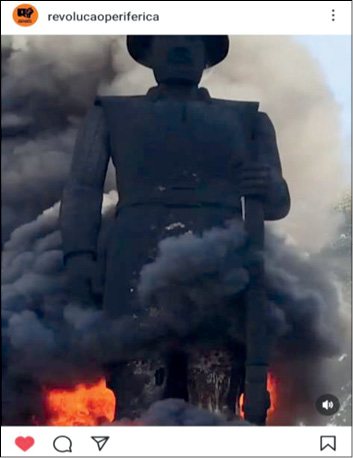
The national context of the act at the Borba Gato monument was that of protests against Jair Bolsonaro, then President of Brazil, held on the same day in several states across the country.7 However, actions involving monuments are part of a broader fabric marked by the contestation of commemorations that glorify figures who promoted the colonization of African, indigenous, and other nonwhite peoples. The intricate weave of this fabric comprises international initiatives and has been extensively invoked in the wake of the #BlackLivesMatter movements, which were initiated in the context of the fight against police violence directed towards African-American individuals.
The world was in the midst of the coronavirus pandemic when the suffocation of the Black man George Floyd by a white police officer was filmed, and his agony, including the words “I can’t breathe” reverberated through the news and social media. The protests against Floyd’s death showed that, despite the risk of contagion, it was necessary to go out to the streets to fight against another omnipresent and suffocating threat: institutional racism. The killing of this young black man epitomized many other deaths that, even in the context of a pandemic, did not cease, including in Brazil. On the contrary, the Black population was not only exposed to constant police violence but also, due to socio-economic circumstances, was more susceptible to dying from COVID-19.8
Following the protests against Floyd’s death, demonstrators in Bristol, England, toppled the statue of slave trader Edward Colston (1636–1721) from its pedestal on June 7, 2020. Lina Choksey9 vividly describes the moments when the protesters blinded Colston, covering him with a black sheet that was thereby transformed into a shroud. He was also rendered as a captive, bound with ropes. The monument was brought down from its pedestal, rolled through the streets, taken to the harbor, and cast into a river. Days later, the statue was retrieved by Bristol authorities, an action described as “an ill-attended wake for history as rational consensus.”10 Then Colston was transferred to a museum. Displayed horizontally and retaining the spray-painted inscriptions added by the protesters, the monument was exhibited at the M Shed museum from June 2021 to January 2022. The temporary exhibition, “The Colston Statue: What Comes Next,” also featured the ropes used to bring down the statue and the placards displayed during the protests. As part of the initiative, a survey was conducted to determine the fate of the artwork and the pedestal that once elevated it in the public square.11
As pointed out by Françoise Vergès,12 the movement to topple and dismantle statues has been a subject of debate in the media, among politicians, and even among activists, stemming from the focused action on the Colston monument. According to this activist and author, the emphasis on events in England establishes a hierarchy of activist actions. Selective media coverage shrouds the silence surrounding political acts pertaining to monuments undertaken in other territories outside Europe, as in the former French colonies and overseas territories.
Claudio Alvarado Lincopi and Ivette Quezada Vásquez13 address the issue of public statues from the standpoint of Chile and Latin America. According to them, the toppling and other acts of demonumentalization in Latin American territories operate within a restorative logic, as they destabilize hegemonic narratives. From their perspective, monumentality can also be seen as a form of sanctification that occurs in the framework of a state religion. Latin American nation’s national histories were constructed in the shadow of republic heroes celebrated in hymns and commemorative marches, rituals that function as masses within this religion. The transformation of an individual into a monumentalized hero, in this sense, both dehumanizes and sanctifies. These figures, as the authors assert, exist beyond time as ethereal, distant, and petrified entities. To secularize these saints, it is necessary to depetrify them and pay heed to the messages conveyed by demonumentalizations. Such actions are tactical paths within a repertoire that counters the colonial imagination and its stone images of heroism. Instead of the glorification of historically violent figures as sacred, almost mythical and religious beings, the demonumentalization process reminds us of an ongoing task. Therefore, it remains strategic even in the absence of physical removal, as it serves as a reminder that the exercise of colonial violence continues to operate in Latin America. Thus, it is not solely the removal of monuments that informs us about the struggle’s progress and its connection with public memory. A diversity of actions shape anticolonial mobilizations as a daily urgency. In contrast to the widespread notion that contemporary demonstrations around monuments culminate in proposals for “erasing history,” demonumentalizing actions add layers to the possibilities of representation in public spaces.
It is notable that the most widely reported cases of demonstrations and statues in Brazil are not related to their dismantling or removal from their pedestals. A search for news articles published in the country using the keywords “statue” and “protest” yields results that mostly relate to the fires set at the aforementioned Borba Gato statue in July 2021 in São Paulo and the statue of Pedro Álvares Cabral14 in August 2021 in Rio de Janeiro.
Several actions redirect attention towards monuments by repurposing them as platforms for diverse interventions, without, however, permanently ruining them. Emerson Giumbelli15 observes that certain material properties of objects in the public space make them suitable to be transformed into canvases for projections. Thus, the Bandeiras Monument, a tribute to the bandeirantes that is often referred to as a São Paulo’s postcard, was employed as a projection canvas for images by the indigenous artist Denilson Baniwa in 2020. In 2013, the Articulation of Indigenous Peoples of Brazil splashed paint onto the sculpture, utilizing the color red and its evocative power to accentuate flowing blood. In the analysis by Thaís Waldman16 on the aforementioned Monument to Borba Gato, we observe interventions in which the bandeirante was put on trial, shackled, covered in red paint, and graffitied with the words “ruralist assassin bandeirante.” The statue of Pedro Álvares Cabral, located in Porto Seguro, Bahia, in reference to the site of Brazil’s “discovery,” was covered with a black canvas in 2021, and the following year it was painted red by indigenous. On this occasion, urucum, a natural dye commonly used for indigenous body art, was the visual element that, when cast upon the statue’s surface, highlighted the bloodstains symbolizing the Portuguese invasion. Indigenous activist and communicator Alice Pataxó reported the action on Twitter (@alice_pataxó, April 22, 2021), and one of the comments on the post questioned: “Can this painting be made permanent? The monument’s update looks amazing. Congratulations!!!”
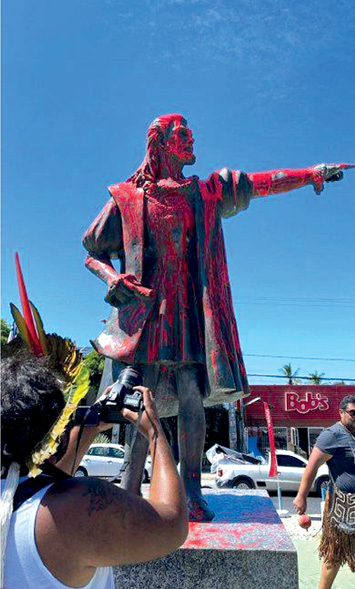
The Bandeiras Monument, the statue of Borba Gato, and those of Pedro Álvares Cabral remain standing, as do other works on Brazilian soil that have previously come under the creative focus of artists and protesters. However, the mentioned actions created ruptures in their respective status as distant and elevated public figures. Despite remaining on their pedestals, these monuments have been called upon to cease being unquestionable and timeless entities. As the commenter on Alice Pataxó’s post aptly noted, they have been “updated.”
They thus become “supports for counter-memory.”17 The concept of counter-memory, found in Michel Foucault’s18 writings, concerns the unfolding of alternative forms of temporality and their effects on the production of knowledge from and about political struggles. This notion is also extended by the author to consider counter-history,19 which, both aesthetically and politically, involves a disagreement with the epic forms of discourse and historical monuments’ development. It is an epistemological opposition to sovereign narrative. Rather than the history of kings, it is the histories of struggles, of various forms of contestation against domination. These are testimonies vocalized by different narrators who do not position themselves solely as victims, but also as agents with a voice and alternative forms of participation in the public arena, often through artistic creations that subvert well-known monumental logics.
Marielle Franco (1979–2018) was a prominent human rights advocate, councilwoman, and Brazilian political activist. She was assassinated on March 14, 2018, along with her driver Anderson Gomes, in the central region of Rio de Janeiro. She had numerous opponents due to her outspoken stance, particularly, against police abuses in poor neighborhoods and her political defense of the rights of women and black people. The execution of Marielle Franco deeply marked a moment in Brazil, setting a political murder in the heart of public discourse. Her death and its circumstances further heightened the sense of political polarization in the national arena, casting suspicion on the family of Jair Bolsonaro, who was then a presidential candidate. Franco shared the Rio de Janeiro City Council with one of his sons.
A crucial argument that emerged around the crime was that killing Marielle Franco was also an attempt at annihilation, erasing black, female, and peripheral bodies that challenged the heteronormative logic of established positions of white, male, cisgender power. The gendering and racialization of the discourse were also central to the construction of alternatives in left-wing politics, seeking to anchor themselves in Franco’s legacy and memory to contest the elections that happened in the same year. In the trauma caused by her death (understood as part of experiences prevalent in a deeply racist, misogynistic and economically unequal society like Brazil’s), there was a search for possibilities of honoring her legacy.
Many elements are mobilized in the struggle for nonforgetting and the elaboration of Marielle Franco’s memory as a way of continuing her political advocacy for human rights. The collective mourning transcended the boundaries of direct affection from friends, colleagues, voters, and especially family members. On the day after her murder, the wake mobilized a crowd in front of the City Council of Rio de Janeiro. The Mexican proverb “they tried to bury us, but they did not know we were seeds” was one of the ideas that helped to give meaning to the collective consternation experienced at that moment. Strongly motivated by this notion, we have already discussed the objects that cultivate Marielle Franco’s memory, bringing forth in the public space the echoes of her demands and the call for justice for her death.20 In the wake of this reflection, in the following, I explore the interaction between memory initiatives and political activism that take Marielle Franco as their motivation, and the growing debate about the presence of statues in public spaces. As will be seen, the tributes to Marielle Franco constitute a kind of open work, a collective creation, with a significant role played by Black and feminist movements.
The most emblematic tribute to this public figure is the plaque “Marielle Franco Street,”21 initially installed in 2018, covering a street sign that indicated the name of “Marshal Floriano Square”22 in downtown Rio de Janeiro. The plaque also displayed her birth year (1979) and the year of her death (2018), along with her introduction: “Councilwoman, defender of Human Rights and minorities, cowardly assassinated on March 14, 2018.” Further below, the ZIP code 20260-080, followed by Estácio, provides information about the location where Marielle Franco and Anderson Gomes were executed. Thus, the plaque is a memorial object23 that doesn’t precisely mark a specific geographical point but rather a crossroads of difficult memories: the location of her death in Estácio neighborhood and the space where Marielle Franco worked as a councilwoman in the center, the City Council.
Marshal Floriano Square, like many other toponyms in Rio de Janeiro, pays homage to an authoritarian Brazilian military and politician. The square also hosts a statue in which the marshal is depicted, elevated on a pedestal, holding a sword. The monument carries messages about love, the preservation of order, and patriotism, despite housing allegories about Portuguese conquest and the presence of enslaved Africans, inherently violent processes. This array of elements stands in front of the City Council of Rio de Janeiro, in the area known as Cinelândia, a historic stage for numerous political demonstrations. The act of renaming Marshal Floriano Square as Marielle Franco Street served as a reminder that it was one of the spaces where the councilwoman worked. It was also the site of her wake.
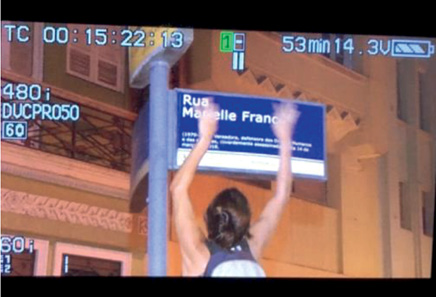
The “Marielle Franco Street” plaque was created by an anarchist artist who installed three copies in downtown Rio de Janeiro in 2018.24 The integration of this sign street into the urban environment of Marshal Floriano Square was disrupted by two far-right candidates running for state and federal deputy positions. Shortly after, they exhibited it at a rally in Petrópolis, located in the interior of the state. The plaque was showed torn in two, serving as a trophy. This incident occurred a week prior to the first round of the 2018 state and national elections.
In contrast to the somewhat clandestine nature of the artist’s affixing of the plaque on the streets of Rio, the display of the fractured street sign was a male performance, marked by a demonstration of violence. In a widely circulated photograph of the rally, one of the then-candidates for deputy posed showing his muscular arm, while his ally, wearing a shirt with the face of Jair Bolsonaro, held the two pieces of the plaque. The candidates in question claimed zeal for the public heritage as a motivation for removing the street sign. For them, the intervention that combined homage to Marielle Franco and questioning the name of the square was an act of vandalism.
The reaction to the candidates’ action was vigorous. On the same day the action against the plaque was publicized, an online campaign was launched to print a hundred new plaques. The funds raised far exceeded what was needed for the creation of a hundred plaques and enabled a thousand to be printed. They were distributed during a public protest against the attack on Marielle Franco’s memory, exactly seven months after her death, and at the same location where her wake was held.
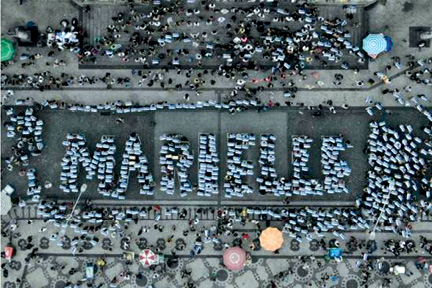
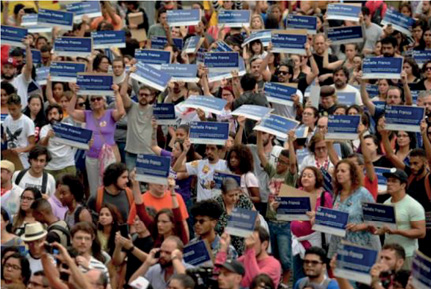
After receiving the plaques, the protesters formed a human mosaic spelling out the name of the murdered councilwoman, visible only from an aerial perspective. Voice was also used as an instrument of protest. Without microphones, the demonstrators shouted slogans such as “not him,”25 “never again dictatorship,” “fascists shall not pass,” “whoever messed with Marielle stirred the anthill.” The plaques were given out with an envelope, and attendees were advised to keep them as they left the protest site. Given the defense of violence promoted in various ways by opponents of Marielle Franco, including the attack on the plaque, the visibility of the object could put those carrying it through the streets at risk.
The plaques continued to multiply and became recurring appearances at public events and activists’ residences. Streets, squares, and gardens, even outside Brazil, were named after Marielle Franco. The “Rua Marielle Franco” website hosts a map of locations where plaques in honor of the councilwoman have been installed, both in Brazil and around the world. This website offers the “art” of the plaque with the intention of “taking the plaques to every corner and showing that Mari is as big as the world!”26 This initiative encourages printing at cost price, thus opposing the commercial exploitation of the object, which can now be purchased on the e-commerce platforms of major retailers.
In addition to the replication of street-renaming plaques, it is important to note that hundreds of murals depicting Marielle Franco adorn the walls of Brazilian cities. Hércules Xavier da Silva Ferreira, the author of a mapping project focusing on these tributes, highlights their artistic diversity: “kites, earrings, tattoos, T-shirts, bloc flags, wooden sculptures, sewing, street plaques, felt dolls, carnival block, dictionary entries, festivals, etc. Her memory is in transit.”27 The Marielle Franco Institute, established by Franco’s family, is currently mapping collectives, movements, and organizations inspired by her. The diversity of memory initiatives and political activism reaffirms the demand for responses and justice for the death of Marielle Franco.
Three years after her tragic demise, on March 14, 2021, the Rio de Janeiro city council unveiled a plaque in Cinelândia. This was the same location where one of the street signs had been installed in 2018 and subsequently removed by far-right politicians. The plaque installed by the city council maintains the same visual presentation as Rio de Janeiro’s street signs and, consequently, that of the artist’s “original” intervention. Looking quickly, it might appear as another reproduction of the famous plaque. Nevertheless, in the city’s homage, Marielle Franco’s name no longer designates a physical space. The wording “Marielle Franco Street” has been substituted with “Councilwoman Marielle Franco.” Marielle Franco’s biography has been enriched with important particulars about her: “woman, Black, from a favela, LGBT.” Lastly, the new version does not reference the site of her death. The area where this information was once displayed now bears the inscription “brutally assassinated on March 14, 2018, for advocating for a more equitable society.”
The “Marielle Franco Street” does not officially exist in Rio de Janeiro as a registered space. The “Councilwoman Marielle Franco” plaque unveiled by the city council needs to be understood in conjunction with graffiti, stickers, stencils, flags, and posters scattered across walls and other surfaces. In these, we encounter the questions, which are also persistently posed in digital social media: Who ordered Marielle’s assassination? And why?28
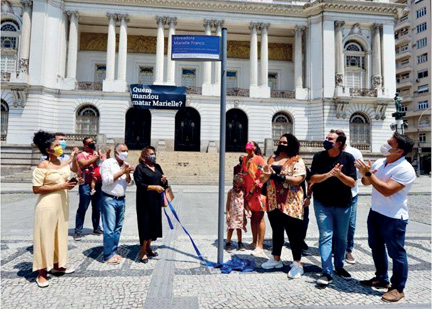
More or less provisional urban interventions – such as critical toponymy actions, posters, stickers, or graffiti – incite diverse patterns of engagement among people, objects, and the city. Some of these interventions can become long-lasting and be perceived as creative alternatives to monumental forms. However, they do not quell people’s desire to provide a lasting public expression of memory through a more permanent material form.
On July 27, 2022, the day when Marielle Franco would have turned 43, a statue in her honor was inaugurated in downtown Rio de Janeiro. The invitation video for the inauguration ceremony depicted statues being toppled in different locations – Belgium, Colombia, England – along with the burning figure of the bandeirante Borba Gato in Brazil. The words read: “Torturers, colonizers, slaveholders will no longer be celebrated. We will honor the memory of our heroines and heroes. Memory is the seed for new futures!”29 As the video argument pointed out, the unveiling of Marielle Franco’s statue is part of an international repertoire of struggles for the transformation of cities’ memorial culture.
The statue was crafted in life-size, measuring 1.75 meters, the height of the councilwoman. Marielle Franco was portrayed wearing a dress, her hair secured by a band, fist clenched and raised, legs apart, mouth slightly open, poised between a smile and a word. The sculpture was created by the sculptor Edgar Duvivier, and the monument’s design (including gestures, attire, and accessories, among other aspects) was shared with Marielle Franco’s family.
The monument was installed in Mario Lago Square, a location historically used by Marielle Franco and her fellow political party members. The square is situated close to one of the city’s busiest metro stations and serves as a daily passageway for thousands of individuals. It’s also a resting and leisure spot for workers during breaks between shifts, and a place of work for numerous street vendors. Among its many uses, the square also serves as a gathering point for left-wing politicians’ speeches during lunchtime. The presence of the artwork there serves as a reminder that Marielle Franco utilized this form of activating public space.
The idea for the monument originated from the Institute bearing her name. A public consultation was conducted to broaden the concept of the artwork based on the sculptor’s ideas and Marielle Franco’s family input. An online mobilization sought financial contributions to make its creation possible. The piece was crafted by Edgar Duvivier, the creator of other public statues of the streets of Rio. The decision to create the sculpture in life-size scale further connects Marielle Franco with those passing by. She stands not on a pedestal, but on a concrete base that also symbolizes the crate she used to step onto when making her calls and reports. This base lies a plaque containing biographical information about her and details of the statue’s financing through crowdfunding.
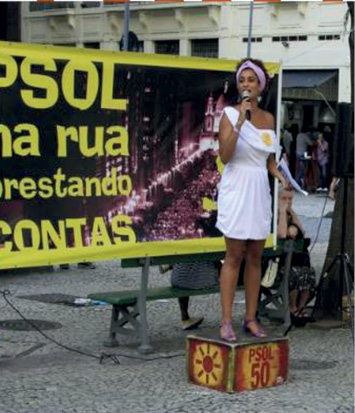
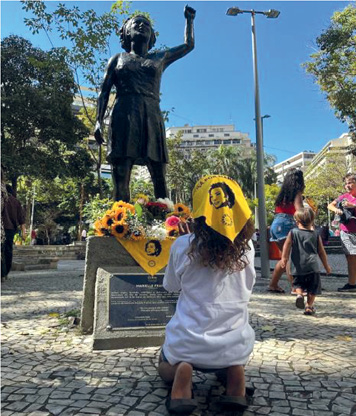
The statue’s inauguration began in the morning with a mass in honor of the councilwoman. Several hours later, the statue was formally unveiled in the public square. The fabric covering was removed after a final countdown, culminating in the collective shout “Marielle lives!” People also joined in by applauding and capturing videos and photos of the newly revealed statue. The statue remained protected by railings, yet an opening allowed for a closer look. A queue formed as people eagerly waited to take photos with it. During the photo sessions, many held hands with the represented councilwoman. Some mimicked her raised-fist gesture.
At nightfall, the master of ceremonies, Anielle Franco,30 summoned the audience to the square’s amphitheater. The lecture “Memory is the seed for new futures: legacy, justice, and reparation”31 was presented by writer Eliana Alves Cruz, lawyer, professor, and activist Thula Pires, and actress Fatou Ndiaye. These Black women of different generations, seated facing Marielle Franco’s statue, discussed the manifold meanings of that sculpture in the public square.
Fatou Ndiaye, the youngest among them, emphasized how her generation now has access to racial debates that were previously confined to academic spaces. However, she underscored that the youth must not disregard the past. The experiences of those who came before pave the way for new futures. Marielle Franco made history, and the gathering around the monument dedicated to her is also a part of history. It’s a celebration of the prominence of Black women, who are often overshadowed.
Eliana Alves Cruz pointed out the significance of Marielle Franco’s statue as a document that counters the persistent notion that “Brazil is a country without memory.” Clearly, having no memory is impossible; the issue lies in the selectiveness of memory: “Brazil wants to forget certain things and wants to remember others.” As the writer reminded, the imposition of forgetfulness is remembered by Afro-diasporic ancestors through the memory of a farewell ritual. In Africa, those kidnapped to be enslaved in Brazil were made to walk around a “tree of forgetfulness.” The intention was for them to forget their past and cultural identity, becoming beings without any desire to react or rebel.
According to the lecturer, Marielle Franco’s statue represents a “subversion of the tree of forgetfulness.” It’s widely recognized that, despite persistent attempts to erase history, oral traditions have enabled memories to be transmitted across generations of Black individuals. However, this doesn’t negate the significance of creating monuments and other forms of historical documentation by these communities. An overarching principle guiding this endeavor is the concept of ancestry, which extends beyond the past and encompasses the present, enabling the envisioning of future possibilities. Hence, it’s imperative to nurture gatherings centered around life, empowering it to assert itself among those consistently confronted with the prospect of being abruptly erased from the public sphere.
Thula Pires highlighted that the statue, much like the renaming of places, offers the opportunity to imbue these elements with meanings that connect them to a commitment to life rather than elimination. The activist emphasized the significance of understanding Marielle Franco’s memory in tandem with the notion of Ori. In the context of Afro-Brazilian religions, Ori refers to the guiding principle, the force that directs each individual’s head, akin to a form of personal divinity. The human head holds both knowledge and spirit. The word memory in Portuguese, memória, encompasses the letters and the sense of Ori within its composition. As Thula Pires elucidated, Ori enables us to conceive of the past, present, and future as a nonlinear succession of events. Navigating the intricate paths of erasure compels us to map out the resurgence of memories usurped by the legacy of colonialism. With Ori at the core of the comprehension of memory, allowing its ritualization, the possibility emerges for those guided by it to reconstruct themselves as individuals, as people, and as political communities.
Thula Pires’ contemplation of memory through the lens of Afro-Brazilian religions engaged in a dialogue with the concept of Amefricanity, as conceived by Lelia Gonzales.32 The term was coined by Gonzales to underscore the pivotal role of the black diaspora in shaping cultural dynamics both within and beyond the confines of the Brazilian State. This concept serves as a crucial counterpoint to the efforts to construct a Brazilian national identity predicated on the homogenizing assimilation of cultures, which often results in the erasure of black and indigenous resistances. Amefricanity transcends linguistic and national boundaries, fostering conversations across the diverse spectrum of social struggles in Latin America conducted by racialized communities.
In the days and months following the inauguration of the statue in honor of Marielle Franco, we have continued to observe the new monument. It has drawn various forms of engagement from city center workers, tourists, passersby, as well as activists who gather around it during diverse political events. We have noticed the creation of photographs both of and with the statue. Other acts of homage, such as the placement of flowers, have also been a common practice.
The monument serves as a platform for the visibility of issues that go beyond mourning for Marielle Franco and the quest for answers about her assassination. In 2022, for instance, Marielle Franco’s statue was photographed adorned with a green scarf tied around her neck.33 This is the green pañuelo, a symbol of the fight for abortion rights in Argentina, which has been embraced as an emblem connecting demands for reproductive rights across Latin America.
The statue was enacted in a square that had been officially registered as a cultural heritage site of the State of Rio de Janeiro since 2020. Consequently, only the construction and installation of facilities for cultural activities were allowed within its premises. This square is regarded as a “lung” that allows the downtown area to breathe. Through legislative initiative by one of those responsible for the attack on the “Marielle Franco Street” plaque, the square recently lost its status as a cultural heritage site. According to the author of the bill 2019/2023, the area is underutilized, reflecting the center of the city’s decline exacerbated during the COVID-19 pandemic, and it is deemed devoid of any historical or cultural heritage. The parliamentarian’s intention is to replace the square with a large building, which, much like certain military monuments, embodies power in phallic and vertical forms. A group of members from the State Council responsible for registering cultural heritage items has requested that not only the square be reinstated as a cultural heritage site, but also the statue of Marielle Franco, due to its “inclusive and gregarious aspect.”34
We are debating the life and death of statues because it is necessary, as argued by Philogene Heron, to confront the visible scars on the social body of cities inhabited by repressed memories.35 The author reaffirms that we need to find ceremonies and restorative practices – whether they are smoke rituals for empty pedestals, festive burials, renaming of places, public apologies, and more – that allow for collective mourning. The ceremonial work, besides fostering emotional healing, is also a claim of common ownership over civic space.
In this sense, the process of demonumentalization, the renaming of a square, and the inauguration of a statue, as discussed in this text, formalize practices and objects around tangible focal points in advocating for alterations in visibility politics. These events are political rituals that contribute to the continuous formation of collective bodies. The rituals in question enable us to engage with the potency of monuments and other memorial objects alongside insurgent practices, influencing the reflection and the transformation of the urban fabric.
Thus, statues and bodies in assembly, fighting for recognition and for a livable life,36 both question and activate public space. It involves congregating collective life to make the city breathe. To mourn lives that were not allowed to live and die with dignity, uniting struggle and mourning, revolt and the search for reparation from colonial trauma.37 To rename spaces, offer and attend public lectures, dance, shout, and display signs with slogans, gesture – in short, participate in actions that seek to destabilize the power devices symbolized in monuments of white men, military figures and their counterparts.
This article explores the conflicts of memory surrounding Brazilian monuments, focusing on their role as messengers of traumatic pasts that require collective discussion and reparation measures. The analysis encompasses both statues of oppressors and objects that counteract the logic of images of control, highlighting the struggle against forgetting.
The debate concerning the presence of monuments in public spaces, exemplified by the Borba Gato statue in São Paulo, underscores the potency of these elements to be reenacted in public memory. The performance around this statue brings us into contact with activists and individuals related to the oppression exerted by the explorer in the past, prolonged by the materiality of the statue in the present.
The case of Marielle Franco has been central to this exploration, illustrating the intersectionality of race, class, gender, and LGBT in mnemonic disputes in the Global South. The tributes to the councilwoman, analyzed as collective authorship by black and feminist movements, have demonstrated the diversity of memory initiatives and political activism. These tributes, along with other forms of counter-memory supports, have been identified as focal points for understanding the relationship between objects, activism, memory, and public life.
References
Butler, Judith. Corpos em aliança e a política das ruas – notas para uma teoria performativa de assembleia. Rio de Janeiro: Civilização Brasileira, 2019.
Choksey, Lara. “Colston Falling.” Journal of Historical Geography 74 (2021): 77–83. https://doi.org/10.1016/j.jhg.2020.07.007
Cole, Timothy, and Janna Burch-Brown et al. The Colston Statue: What Next? ‘We are Bristol’ History Commission Full Report. Bristol, 2022.
Foucault, Michel. Em Defesa da Sociedade. São Paulo: Martins Fontes, 2005.
Foucault, Michel. Language, Counter-memory, Practice: Selected Essays and Interviews. Ithaca, NY: Cornell University Press, 1977.
Giumbelli, Emerson. “Objetos 22, ou monumentos em movimento.” In Objeto 22: IV Seminário MARES: Materialidade, Arte, Religião, Espaço Público, edited by Julia Vilaça Goyatá, Edilson Pereira, and Paola Lins de Oliveira, 18–27. São Luís, MA: Ed. dos Autores, 2022.
Gomes, Lilian Alves, and Patrícia Lânes. “Pedras no caminho do esquecimento: monumentos, ações desmonumentalizadoras e contramemoriais no espaço público.” Entropia 8(15) (2024): 207–237.
Gonzalez, Lélia. Por um feminismo afro-latino-americano. Rio de Janeiro : Zahar, 2020.
Gutman, Yael, and Jenny Wüstenberg. “Introduction: The Activist Turn in Memory Studies.” In The Routledge Handbook of Memory Activism, edited by Yael Gutman and J. Wüstenberg, 5–15. Routledge, 2023.
Kilomba, Grada. Memórias da plantação – episódios de racismo cotidiano. Rio de Janeiro : Cobogó, 2019.
Lânes, Patrícia, and Lilian Alves Gomes. “Marielle Franco: objetos-semente na luta por justiça e memória.” In Lugares de Memórias Difíceis no Estado do Rio de Janeiro, edited by Myrian Sepulveda dos Santos, Ana Paula Fernandes, and Gabriel Vidal da Silva Cid, 367–375. Rio de Janeiro : Mórula, 2024.
Lânes, Patrícia, and Lilian Alves Gomes. “Rua Marielle Franco e Beco Eduardo de Jesus: Toponímia Urbana e Conflitos de Memória no Rio de Janeiro.” In Memória coletiva: entre lugares, conflitos e virtualidade, edited by Daniele Bezerra [et al.], 142–155. Porto Alegre, Pelotas : Casaletras, PPGMP/UFPel, 2021.
Lincopi, Claudio Alvarado, and Ivette Quezada Vásquez. “Derribar, sustituir y saturar. Monumentos, blanquitud y descolonización.” Corpus. Archivos virtuales de la alteridad americana 11(1) (2021): 1–11.
Oliveira, Roberta Gondim de, et al. “Racial inequalities and death on the horizon: COVID-19 and structural racism.” Cadernos de Saúde Pública 36, no. 9 (2020): 1–14.
Philogene Heron, Adom. “Goodnight Colston. Mourning Slavery: Death Rites and Duppy Conquering in a Circum-Atlantic City.” Antipode 54 (2022): 1251–1276. https://doi.org/10.1111/anti.12831
Vergès, Françoise. “Derrubar uma estátua, haverá algo mais legítimo?” Revista Punkto 28 (2020).
Waldman, Thaís Chang. “Os bandeirantes ainda estão entre nós: reencarnações entre tempos, espaços e imagens.” Ponto Urbe [Online] 25 (2019).
Sites, youtube videos and social media
“A memória é a semente para novos futuros.” YouTube video, August 1, 2022. Accessed June 15, 2023. https://www.youtube.com/playlist?list=PLWP6juFDi1g-QLIdR1r5suGpB-xNAKYEy.
Alice Pataxó (@alice_pataxo). “Indígenas se manifestaram hoje na cidade de Porto Seguro contra as comemorações do falso Descobrimento e a visita de Jair Bolsonaro, pedindo justiça, demarcação de terras e #ForaBolsonaro,” Twitter, April 22, 2021. https://twitter.com/alice_pataxo/status/1517549957611507713.
Carta Capital. “Ato distribui mil placas com nome de Marielle no Rio,” October 15, 2018. Accessed June 15, 2023. https://www.cartacapital.com.br/sociedade/ato-distribui-mil-placas-com-nome-de-marielle-no-rio/.
COMPA – Arquivo das Mulheres. Accessed September 18, 2022. http://www.arquivocompa.org and https://www.facebook.com/arquivocompa.
El Pais Brasil. “Prisão de ativista que queimou Borba Gato provoca debate sobre a memória de São Paulo,” July 28, 2021. Accessed June 15, 2023. https://brasil.elpais.com/brasil/2021-07-29/prisao-de-ativista-que-queimou-borba-gato-provoca-debate-sobre-a-memoria-de-sao-paulo.html.
Freire, Quintino Gomes. “Buraco do Lume pode ser novamente tombado,” Diário do Rio, January 8, 2023. https://diariodorio.com/buraco-do-lume-pode-ser-novamente-tombado/.
Instituto Marielle Franco. Accessed April 15, 2024. https://www.institutomariellefranco.org/.
Instituto Marielle Franco, @institutomariellefranco. “Nota pública sobre a prisão dos possíveis mandantes do assassinato de Marielle Franco e Anderson Gomes.” Instagram photo, March 24, 2024. https://www.instagram.com/p/C46OciEJR34/?igsh=aXdhNXJmcHNnZjUx.
Prefeitura do Rio. “Prefeitura inaugura placa em homenagem a Marielle Franco nos três anos de sua morte.” March 14, 2021. Accessed June 15, 2023. https://prefeitura.rio/cidade/prefeitura-inaugura-placa-na-cinelandia-em-homenagem-a-marielle-franco-nos-tres-anos-de-sua-morte/.
Revolução periférica. Instagram. Accessed June 15, 2023. https://www.instagram.com/revolucaoperiferica/?hl=pt.
Rua Marielle Franco. Accessed June 15, 2023. https://www.ruamariellefranco.com.br/.
The Intercept Brasil. “Dos entregadores antifascistas ao fogo no Borba Gato, Paulo Galo quer criar a faísca da revolução.” November 25, 2021. Accessed June 15, 2023. https://www.youtube.com/watch?v=FN4SLdxYp3Y&t=1161s.
Wiki Favelas. “Mapeamento das homenagens à Marielle Franco.” Accessed June 15, 2023. https://wikifavelas.com.br/index.php/Mapeamento_das_homenagens_a_Marielle_Franco.